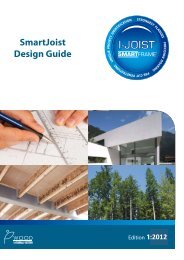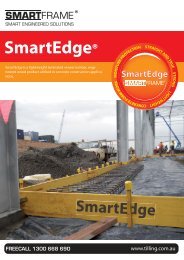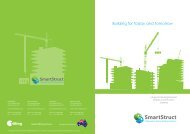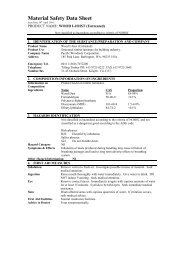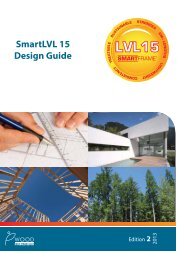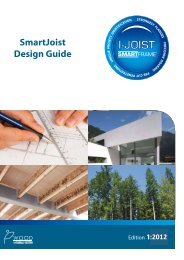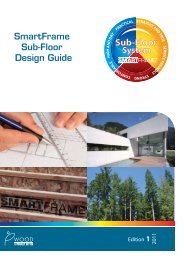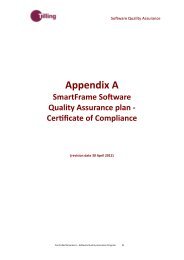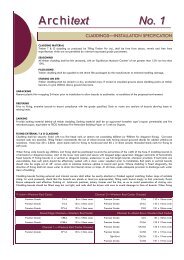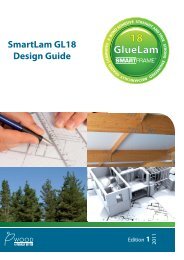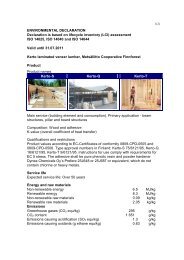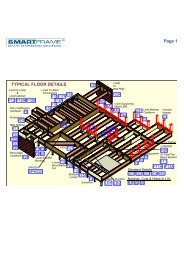SmartFrame Subfloor Design Guide - Tilling Timber
SmartFrame Subfloor Design Guide - Tilling Timber
SmartFrame Subfloor Design Guide - Tilling Timber
You also want an ePaper? Increase the reach of your titles
YUMPU automatically turns print PDFs into web optimized ePapers that Google loves.
DURABILITY AND EXPOSURE TO MOISTURE<br />
SmartLVL is manufactured from softwood species which<br />
has a durability rating of class 4, which is the same rating<br />
as some Ash type Eucalypts. Untreated SmartLVL should<br />
not be used where the equilibrium moisture content is likely<br />
to remain above 20% for an extended period.<br />
Untreated SmartLVL is suitable in the internal, fully protected,<br />
ventilated and the external above ground, protected<br />
zones of the structure as shown below. Untreated<br />
SmartLVL is not suitable for external above ground, exposed<br />
or humid indoor conditions, such as swimming pool enclosures.<br />
DEFINITIONS OF EXPOSURE CLASSIFICATIONS<br />
The table below shows the moisture content of LVL as a<br />
function of humidity.<br />
Moisture content of wood products % 1<br />
Relative Humidity %<br />
LVL MC<br />
10 1.2<br />
20 2.8<br />
30 4.6<br />
40 5.8<br />
50 7.0<br />
60 8.4<br />
70 11.1<br />
80 15.3<br />
90 19.4<br />
1. Approx moisture content at 21 0 C<br />
1. DIMENSIONAL CHANGE<br />
* External timbers are regarded as protected in AS 1684 if they are covered by a<br />
roof projection (or similar) at 30° to the vertical and they are well detailed and<br />
maintained (painted and kept well ventilated).<br />
MOISTURE EFFECTS ON LVL<br />
SmartLVL is supplied WITHOUT any short term construction<br />
sealer, but once framed into a structure may be exposed to<br />
the weather for a limited time (not greater than 3 months)<br />
without negative affect, BUT, it may exhibit some effects of<br />
this exposure.<br />
SmartLVL, like all wood products, is hygroscopic, which<br />
means it has an affinity for water. SmartLVL will readily take<br />
up and release moisture in response to changes in the local<br />
environment. Moisture exposure will lead to dimensional<br />
change. While the products will withstand normal exposure,<br />
excessive exposure during distribution, storage or construction<br />
may lead to dimensional changes that affect serviceability.<br />
These changes include cupping, bowing or expansion to<br />
dimensions to beyond the specified tolerance of the product<br />
in the “as-manufactured” condition.<br />
Individual members of a vertically laminated multi member<br />
may exhibit some cupping if water becomes trapped between<br />
the laminates. This cupping produces more of a visual<br />
and possible fixity problem rather than being structurally<br />
significant. If not properly dried out, this moisture between<br />
laminated members may lead to decay. To prevent this effect,<br />
use construction details as shown in full SmartLVL<br />
<strong>Design</strong> <strong>Guide</strong>s.<br />
As an organic material, mold and mildew may grow on untreated<br />
wood products if moisture is present. Prolonged<br />
periods of high moisture may also support the growth of<br />
wood decay fungi, which is another reason to follow proper<br />
methods of storage and handling of LVL.<br />
SmartLVL will shrink and swell in proportion to changes in<br />
their moisture content between 0 and 28 % fibre saturation<br />
point. The most significant moisture movement will occur<br />
across the grain (tangential and radial directions within a<br />
log). Longitudinal (movement in the grain direction) may be a<br />
factor depending upon the type of structure . Detailing of<br />
SmartLVL to be used where moisture contents will cycle<br />
should allow for dimensional instability.<br />
The amount of dimensional change in a piece of LVL due to<br />
changes in moisture content can be APPOXIMATED by the<br />
following formula:<br />
ΔD = D i S (MC i - MC f )/FSP<br />
Where:<br />
ΔD = change in dimension<br />
D i = Initial dimension<br />
S = Shrinkage coefficient = approximately 6%<br />
MC i = Initial moisture content<br />
MC f = final moisture content<br />
FSP = fibre saturation point approximately 28%<br />
E.g. 200 x 42 LVL 15 with MC change from 12-18 %<br />
- Increase in breadth (thickness) 0.5 mm<br />
- Increase in depth 2.6 mm<br />
2. CHANGE IN CHARACTERISTIC STRENGTHS<br />
Changes in moisture content in wood results in changes in<br />
mechanical properties, with higher properties at lower moisture<br />
contents. Estimates of the effect of moisture differentials<br />
on the properties of clear wood may be obtained by the<br />
following equation:<br />
P = P<br />
12<br />
<br />
<br />
P<br />
Pg<br />
12<br />
Where:<br />
P= Characteristic property at moisture content<br />
P 12 = same Characteristic property at 12% moisture content<br />
P g = same Characteristic property for Green wood<br />
M p = Intersection moisture content = 24% for Doug Fir<br />
<br />
<br />
<br />
<br />
<br />
<br />
<br />
<br />
<br />
12−M<br />
Mp<br />
−12<br />
<br />
<br />
<br />
<br />
<br />
<br />
<strong>SmartFrame</strong> Sub-floor <strong>Design</strong> <strong>Guide</strong> 8



